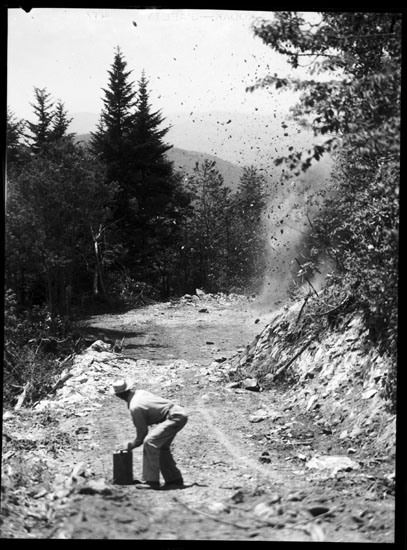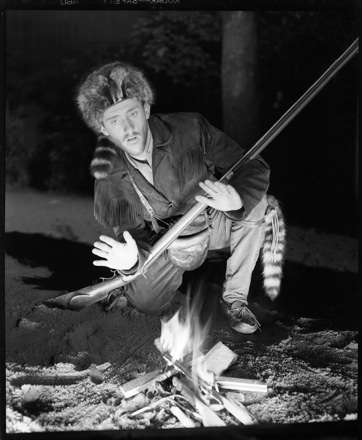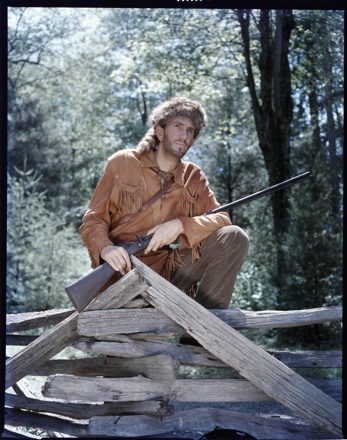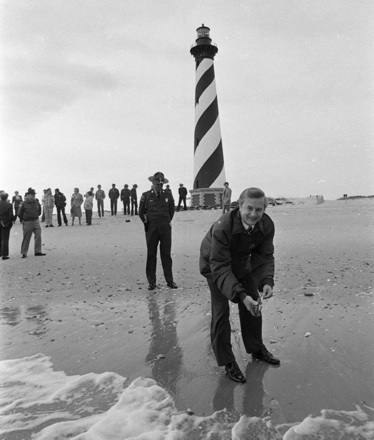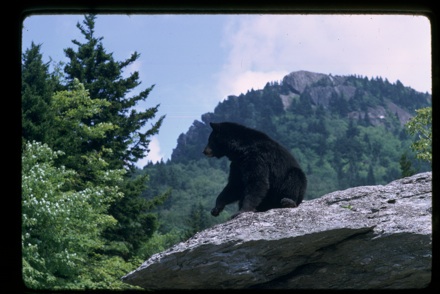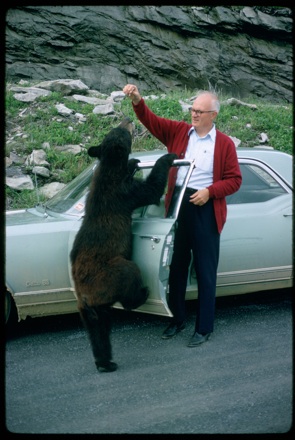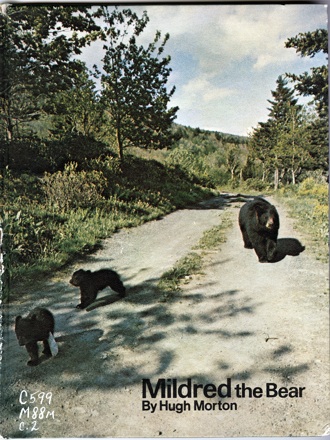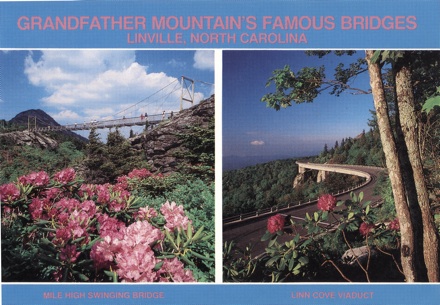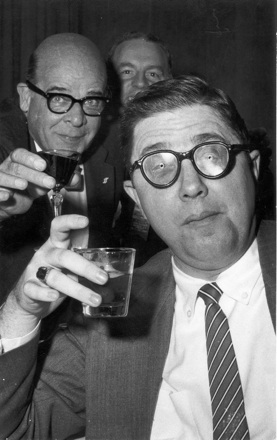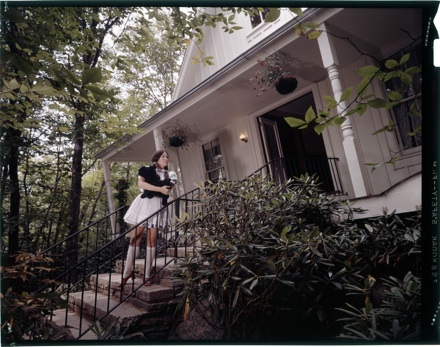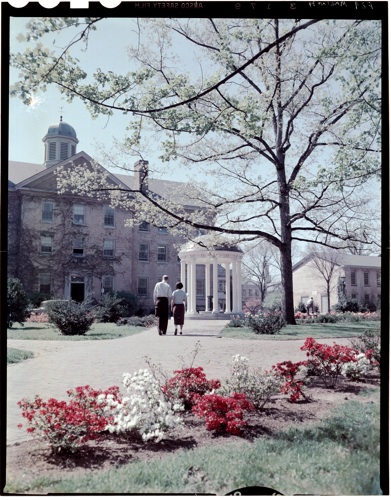
Here in Chapel Hill, the daffodils are blooming, the world is mud-luscious, and the sweet sound of sneezing floats on the breeze. It must be spring!
As the buds begin to blossom, so too does the tourist season in North Carolina. To provide some perspective on the development of the tourism industry in the Old North State (and Hugh Morton’s role in it), we offer our newest essay in the Worth 1,000 Words series: Selling North Carolina, One Image at a Time, by Richard Starnes.
Starnes is an historian specializing in southern history and Appalachia, Associate Professor and History Department Chair at Western Carolina University, and author of the 2005 book Creating the Land of the Sky: Tourism and Society in Western North Carolina.
Read, share, discuss, and enjoy.
Category: Tourism & Development
Grandfather Mountain's new "Top Shop"
Recently Elizabeth told me about the demolition of the old “Top Shop” and the ongoing construction of a new shop on the summit of Grandfather Mountain. I grew up in North Carolina, and my childhood was full of visits to Grandfather Mountain; I loved searching through the gift shop after I walked over the Mile High Swinging Bridge. So to honor the transition from old to new, this post will be dedicated to the progression of development on the summit of Grandfather. (This is just a brief summary; perhaps the staff at Grandfather can provide a more detailed chronology?)
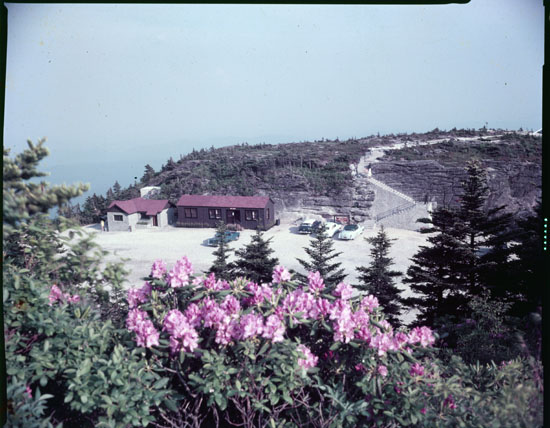
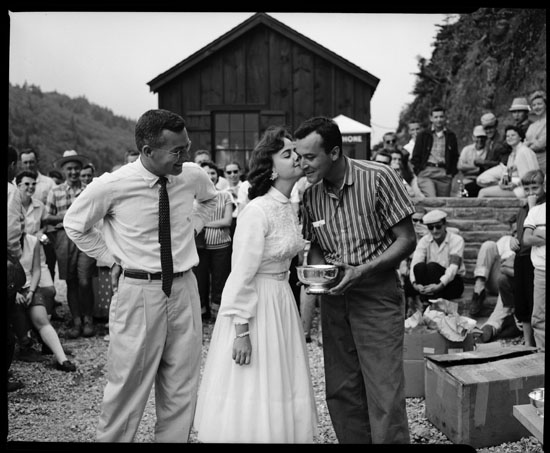
Originally, the gift shop/visitors center on the summit of Grandfather was just a little wooden building, with a stone bathhouse next door, as shown above. The first picture is a view of the first visitor’s center. I like this picture because it shows the quaint nature of the original design of the Grandfather summit. The second picture shows golfer Billy Joe Patton (left) and others at a trophy ceremony for the “Sports Car Hill Climb” event that used to be held annually. The wooden visitors center is in the background. I chose this picture because it shows how the summit was used as an outdoor gathering space.
Morton inherited the land at Grandfather Mountain in 1952. In the 1950s (according to the book Grandfather Mountain by Miles Tager), “the postwar economic boom had by this time returned visitors to the region, opened up by the Parkway and other roads,” after the scarcity of visitors during the Great Depression. Morton took advantage of the prosperity of the 1950s by constructing a new road to the summit, a new parking lot, and a new gift shop. The picture above shows construction of the road to the summit.



The new building, dubbed the “Top Shop,” was constructed in 1961. The first picture is of construction of “Top Shop” visitors center, right before it was completed in 1961. The next picture is of the “Top Shop” soon after it was built. And the last picture is of tourists browsing the new gift shop.
Grandfather Mountain has gone through many phases to become the popular attraction that it is today. The new shop will have many advantages over the old one, will be less of an obstruction to the view of Grandfather’s profile, and is much needed because of the weather damage that happens to buildings on the summit. (To see pictures of the construction of the newest “Top Shop,” click here). But though these transitions at Grandfather Mountain are all for the best, it is nice to look back at the simple beginnings of the wooden gift shop sitting on a barely developed piece of land.
Morton Among the Movers and Shakers
Note from Elizabeth: I’m pleased to present the very first essay from Worth 1,000 Words project, written by journalist Rob Christensen. Rob has been writing about N.C. politics as a reporter and a columnist for 36 years for The News and Observer and The Charlotte Observer; his book The Paradox of Tar Heel Politics won the N.C. Literary and Historical Association’s Ragan Old North State Award for the best work of nonfiction in 2008.
Update 2/9/10: This post has now been converted into its own “page” under the Essays section of A View to Hugh.
Daniel Boone Days are here again!
This weekend (Sept. 4-5) marks the second annual Daniel Boone Days festival in my lovely hometown of Boone, NC. From the looks of it, the festival has really taken off since last year — they’ve attracted some big names and the schedule is “jam packed with activities for all ages and tastes, including children’s music and games, living history, arts & crafts, food & drink, dancing, poetry, storytelling and live performances.” The festivities kick off Friday with the Dr. Edwin Arnold Daniel Boone Symposium today (full disclosure: Dr. Arnold, a.k.a. “Chip,” is my dad, and he was heavily involved with organizing the first festival last year).
It’s a good bet that if Hugh Morton were still around, he’d be in Boone with his cameras this weekend. (In particular, he would NOT miss an opportunity to photograph the setting of a new World Record for the “Most People Dressed Like Daniel Boone at One Time”!).
Like many who live in the Western part of our state, Morton clearly had a Daniel Boone fascination. Besides developing a Boone exhibit for Grandfather Mountain’s Nature Museum, he photographed Boone’s Horn in the West outdoor drama from its early days, when Ned Austin played the famous pioneer (see above), and took many a portrait of Glenn Causey (below), the actor who took over the role in 1956 and played it for the next 40 years! (FYI, the portrait of Horn author Kermit Hunter on the “Horn History” web page is also a Morton image).
Morton also photographed the graves of Boone’s parents in the Joppa Cemetery near Mocksville, as well as Asheville’s competing Daniel Boone drama Thunderland, including the mysterious portrait below, taken circa 1952. (Does anyone know who this is? Thunderland author Hubert Hayes? Composer Lamar Stringfield?)
Hope those attending this weekend’s festivities in Boone will report back! I myself am headed to the opposite end of the state for one last salty taste of sand and surf, before the delicious crisp of fall sets in for good . . .
Battle for the Beacon

Note from Elizabeth: This is the fourth post researched and written by volunteer Jack Hilliard. Ten years ago today, on July 9, 1999, the move of the Cape Hatteras Lighthouse to its new location was completed.
It wasn’t difficult to recognize Hugh Morton when he came to Greensboro in the spring of 1982 for the annual Governor’s Conference on Travel and Tourism. He was the gentleman in the Carolina blue jacket and the yellow tie embroidered with an image of the Hatteras Lighthouse. His lapel button identified him as “Keeper of the Light.”
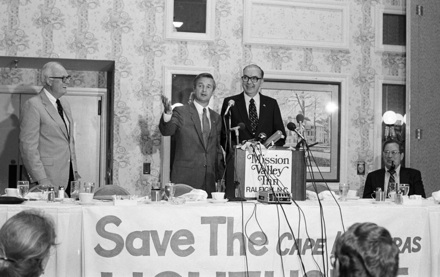 A year before, Morton had formed the “Save the Cape Hatteras Lighthouse Committee,” in response to the growing concerns about the safety of the 129-year-old structure. His committee read like a who’s who in North Carolina: Morton was even able to get his friends (and political foes) Democratic Governor Jim Hunt and Republican Senator Jesse Helms to lead the project. (The two would engage in a 1984 Senate contest that Newsweek magazine called “the most colorful, expensive, and nasty Senate contest in the country,” but in 1981 they were on the same team).
A year before, Morton had formed the “Save the Cape Hatteras Lighthouse Committee,” in response to the growing concerns about the safety of the 129-year-old structure. His committee read like a who’s who in North Carolina: Morton was even able to get his friends (and political foes) Democratic Governor Jim Hunt and Republican Senator Jesse Helms to lead the project. (The two would engage in a 1984 Senate contest that Newsweek magazine called “the most colorful, expensive, and nasty Senate contest in the country,” but in 1981 they were on the same team).
 This powerful group was able to raise $500,000 in a very short time, with Morton using some of the same techniques that he had used 20 years before to bring the Battleship USS North Carolina to Wilmington. The money was used for sandbags, sand fences, and Seascape synthetic seaweed. All of these measures were extremely helpful in building up the beach around the lighthouse.
This powerful group was able to raise $500,000 in a very short time, with Morton using some of the same techniques that he had used 20 years before to bring the Battleship USS North Carolina to Wilmington. The money was used for sandbags, sand fences, and Seascape synthetic seaweed. All of these measures were extremely helpful in building up the beach around the lighthouse.
Morton and Hunt were able to literally measure their success. In an interview for the December, 1997 issue of Lighthouse Digest magazine, Morton said:
“Governor Hunt and I took a tape measure; one of us stood at the base of the light and the other took the tape to the water’s edge–and it was not low tide either. The tape showed it was 310 feet from the water to the tower–quite an improvement over the less than 100-feet when the project started. The seaweed had trapped the sand moving south and built up the land under the water as well as the beach itself.”
"The bear that didn't know she was a bear"
“Mildred the Bear, the nicest bear that has ever been…”
–Hugh Morton
Note from Elizabeth: Allow me to introduce the author of this post, our newest Morton team member, Allison Wonsick. While not “Tar Heel born,” Allison considers herself “Tar Heel bred” as a resident of Hickory, North Carolina, a UNC-CH alumna, and a current graduate student attending Appalachian State University in Boone. She is interning this summer at Wilson Library in the Photo Archives as well as in the North Carolina Collection Gallery.
When my family and I moved to Hickory in 1996, the first place we visited was Grandfather Mountain. We hiked the trails, explored the museum, saw the animal habitats, crossed the Mile High Swinging Bridge on a blustery day, and even saw snow in April (a shock in any month for a former Floridian)–but the most memorable aspect of the trip were the bears, both as residents of the mountain and as symbols of Grandfather Mountain itself.
Particularly iconic, of course, was legendary Mildred. It was clear then and now that she was special. Working with Hugh’s slide collection and family photographs, I can see the bond between Mildred and Morton (and have heard stories of picnics together with Fig Newtons and grape soda), but always wondered how the relationship began. Just how does one become friends with a bear?
Luckily, finding out more information about Mildred was not difficult. It turns out that Morton wrote her biography a few years after her arrival on the Mountain.
So here is a history of Mildred and the bears that followed in her paw prints, courtesy of former zookeeper Laurie Mitchell Jakobsen in her book, The Animals of Grandfather Mountain (published in 2001 by Parkway Publishers, Inc. of Boone, N.C.), and anecdotal tales I’ve picked up while working with the collection.
Continue reading “"The bear that didn't know she was a bear"”
"Driving through Time" project funded

Exciting news! A new two-year digital publishing initiative called Driving through Time: The Digital Blue Ridge Parkway in North Carolina has been approved for funding by the Library Services and Technology Act (LSTA). Work on the new collection begins July 1, and will be heavily based on findings and experimentation from other GIS (Geographic Information Systems)-based projects developed by UNC Libraries and their partners: Going to the Show and North Carolina Maps. (By the way, if you haven’t yet explored these collections, you simply must).
We’re especially thrilled because Driving through Time will include some of Hugh Morton’s Parkway photographs. Here’s a summary of the project provided by the Carolina Digital Library & Archives:
Driving through Time: The Digital Blue Ridge Parkway in North Carolina will present an innovative, visually- and spatially-based model for documenting the twentieth-century history of a seventeen-county section of the North Carolina mountains. The project will feature historic maps, photographs, postcards, government documents, and newspaper clippings, each of which will be assigned geographic coordinates so that it can be viewed on a map, enabling users to visualize and analyze the impact of the Blue Ridge Parkway on the people and landscape in western North Carolina.
Primary sources will be drawn from the collections of the UNC-Chapel Hill University Library, the Blue Ridge Parkway Headquarters, and the North Carolina State Archives. These materials are especially significant in that they document one of North Carolina’s most popular tourist attractions, but also in the way that they help to illuminate the way that the Blue Ridge Parkway transformed the communities through which it passed. In addition to the digitized primary sources, the project will include scholarly analyses of aspects of the development of the Blue Ridge Parkway in North Carolina, and an educational component designed for K-12 teachers and students.
Using digital technologies to open a new window on the history of the Parkway and its region is especially timely considering the approach of the Parkway’s 75th anniversary in 2010 and the National Park Service’s 100th anniversary in 2016. This project is certain to be a valuable and popular resource for millions of tourists as well as for teachers, students, and historians, both within North Carolina and beyond.
World's Largest . . .
Happening upon this CNN.com article about “world’s largest” roadside attractions, I couldn’t help but be reminded of some of the wacky or otherwise superlative NC tourist attractions represented in the Hugh Morton collection.
In the “world’s largest” category, we have, of course, the “World’s Largest Living Christmas Tree” in Wilmington . . . but my personal favorite has to be the “World’s Largest 10 Commandments” at the amazing Fields of the Wood Bible Park in Murphy. (Let me add that this website is DEFINITELY worth a visit). Some historical background for the park can be found here.
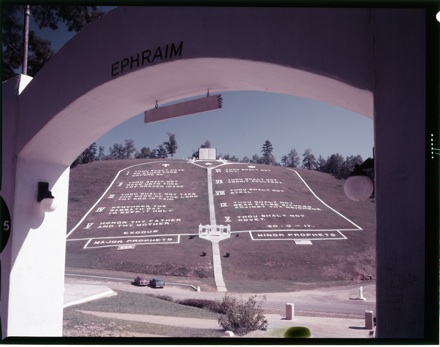
While it doesn’t quite qualify for the “world’s largest” superlative, Jockey’s Ridge State Park in Nags Head does boast itself as “the tallest natural sand dune system in the Eastern United States.” This Morton image certainly captures its expansiveness:
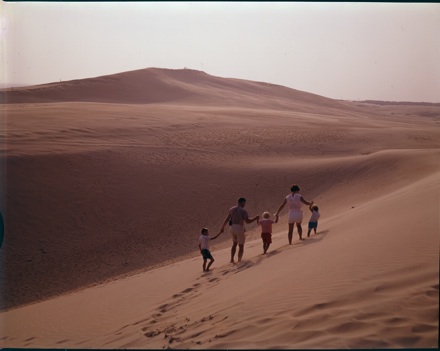
Then we have Asheville’s Biltmore House, known as “America’s largest house”:
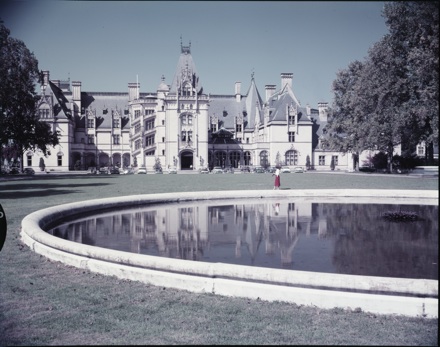
And the Blue Ridge Parkway, which qualifies as the “world’s longest, narrowest national park”:
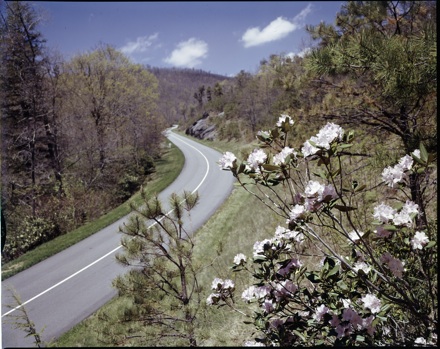
Okay, I may be reaching a bit now (as perhaps are the promoters of these various attractions in their attempts to attract visitors). But there’s no disputing that this a perfect time of year to hit the road and explore our state’s many superlative treasures. May I suggest the fabulous website Roadside America to help you plan your adventure? I myself have always wanted to visit the Taxidermy Hall of Fame and Creation Museum in Southern Pines . . .
Wish You Were Here!
Postcards are an integral part of any vacation. Whether amid the urban sprawl of Charlotte or the peace and quiet of Sunset Beach, you will always find those spinning turnstiles advertising postcards, 10 for a dollar. Grandfather Mountain is by no means immune to this phenomenon.
In our massive collection of images are quite a few postcards photographed, and often published, by Hugh Morton. Some of these postcards can be seen in the North Carolina Postcards collection online: 14 postcards for which Hugh provided the images can be found in the digital collection. Of the 7 Grandfather Mountain images, 4 are Hugh’s (of the Highland Games and pipe bands on the cliffs. Stephen found this collection quite useful about a year ago in helping to identify a specific pipe band).
Most of the postcards donated with the collection are typical scenic views, cuddly bear cubs, or bubbly creeks and waterfalls — ones you might buy from Grandfather Mountain’s gift shop, including familiar images such as this one, this one, and this one. And then you have the one above, a crazy picture with no accompanying description, raising the questions: who are these men, and why would I want a postcard of them?

Some of the postcards are actually quite useful. Many times the descriptions on the back will help us to identify a location, date, or person. The description from the postcard above explains that this is Darby Hinton and Mildred the Bear at the Mile High Swinging Bridge. Darby played Daniel Boone’s son, Israel, from the television series running from 1964-1970. As we were looking for postcards for this blog, Elizabeth exclaimed, “Hey, I’ve seen this kid.” She had run across pictures of him, but hadn’t yet connected them with a name.
The pictures Hugh Morton took for his postcards were used for more than just souvenirs. Grammy Award-winning banjo man David Holt used a Morton postcard to promote himself. Hugh used a postcard of the USS North Carolina to send out his change of address from Wilmington to Linville. It’s nice to see that the photos he took showed the beauty of the surrounding areas and didn’t stoop to the cheesy tourist gimmicks of bathing beauties or ski bunnies.
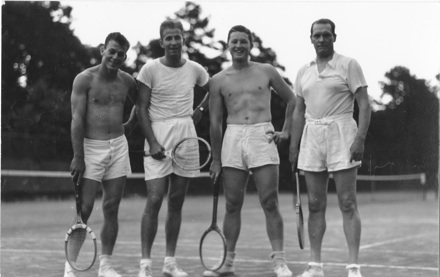
Or did they?
"A Magical Place, Part of Another World"
This past weekend, a weird and wonderful event took place at the top of Beech Mountain, NC: the 15th annual “Autumn at Oz,” a pilgrimage and tribute to the bygone Land of Oz theme park that existed there from 1970 to 1980. (Photos from the weekend, and previous Land of Oz parties, can be viewed here).
I don’t recall visiting Oz myself (I would’ve been pretty young when it closed in 1980), but I do remember seeing leftover artifacts at the now-closed Appalachian Cultural Museum in Boone, and thinking to myself, “what an odd idea for a tourist attraction!” (Along those lines, I recommend the article “In Search of Emerald City,” a fascinating history of the “strange urge to create a life-sized Land of Oz.”)
Hugh Morton took many a photo at Oz during the decade of its existence, most (or all?) of which were for promotional purposes. Here are a few:
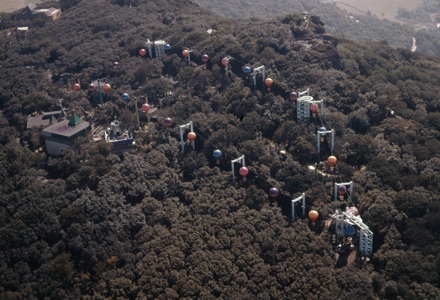
“The Land of Oz was a theme park based on the characters of L. Frank Baum’s book, The Wonderful Wizard of Oz. Built atop Beech Mountain in Watauga County, North Carolina, the park was designed to capitalize on the rugged beauty of the Blue Ridge while providing the activities popular with modern tourists. The Land of Oz was called “exquisite” and an “adventure, imaginative and unspoiled” by the Washington, DC Daily News, which gave the park its annual award in 1970 as the best new tourist attraction in America.
The park’s developers, Grover and Harry Robbins of Boone, NC, and Jack Pentes, the designer of Oz, were determined to preserve the natural environment of the sixteen-acre park. The Land of Oz attracted over 400,000 people in its first year and became the leading tourist attraction in North Carolina almost overnight.
Not only was the Land of Oz owned locally, its construction relied on local carpenters, stonemasons, and renowned craftsmen like Daniel Boone V, who created the wrought iron work for the park. Oz also provided summer employment for some 150 young people who worked as characters, guides, and in the concessions.
The Land of Oz closed in 1980, the victim of the changed resort economy. But for a decade it was what designer Pentes had hoped for — a magical place, part of another world.”
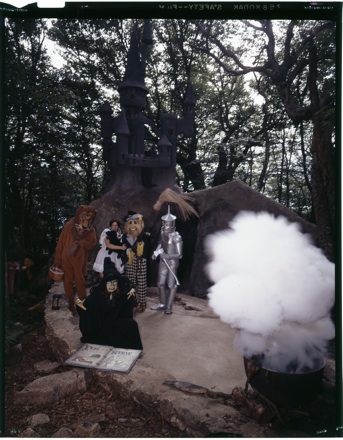 Revision: nonfunctional links updated, changed, or removed on 25 August 2017.
Revision: nonfunctional links updated, changed, or removed on 25 August 2017.

